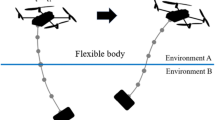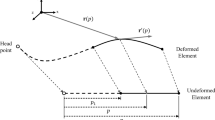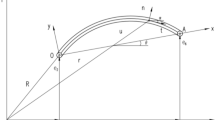Abstract
In the conventional absolute nodal coordinate formulation (ANCF), the model is pre-meshed, the number, distribution and type of elements are unchangeable during the simulation. In addition, the deformations of a flexible body are space-varying and time-varying, one cannot predict when, where, and how the deformations will occur. Therefore, in order to obtain a satisfactory accuracy during the whole simulation, the model is usually densely meshed, but it will result in a loss of computational efficiency. In this study, an adaptive absolute nodal coordinate formulation (AANCF) is proposed to optimize the accuracy and efficiency of flexible dynamics. The movement features of flexible bodies are analyzed, and the conventional and adaptive ANCF methods are compared. Then the adaptive computation strategy is presented. The discretization errors come from the inability of interpolation functions of individual elements to capture the complexity of the exact solution, so the mesh can be adaptively optimized by changing the element sizes or the orders of interpolation functions during dynamic computation. Important issues of AANCF, including error estimation, mesh updating, and performance of the AANCF model, are analyzed and discussed in detail. A theoretical model of a planar AANCF cable is presented, where the strategies of dividing and merging elements are discussed. Moreover, the continuity of dynamic variables is deduced, and the mean factors that affect the continuity are obtained, which is very important for the subsequent continuity optimization. The simulation results indicate that the distribution of elements varies with time and space, and the elements are denser in large-deformed domains. The AANCF model improved the computational accuracy and efficiency, but the system energy is discontinuous when the elements are merged. Therefore, a continuity-optimized AANCF model is given based on the previous continuity analysis, the results show that the accuracy and continuity of energy are further improved by the continuity-optimized AANCF model.















Similar content being viewed by others
References
Wasfy, T.M., Noor, A.K.: Computational strategies for flexible multibody systems. Appl. Mech. Rev. 56, 553–613 (2003)
Shabana, A.A.: Dynamics of Multibody Systems. Cambridge University Press, Cambridge (2005)
Shabana, A.A.: An Absolute Nodal Coordinate Formulation for the Large Rotation and Large Deformation Analysis of Flexible Bodies. Technical Report No. MBS96-1-UIC (1996)
Shabana, A.A.: Definition of ANCF finite elements. J. Comput. Nonlinear Dyn. 10, 054506 (2015)
Shabana, A.A., Yakoub, R.Y.: Three dimensional absolute nodal coordinate formulation for beam elements: theory. J. Mech. Des. 123, 606–613 (2001)
Yakoub, R.Y., Shabana, A.A.: Three dimensional absolute nodal coordinate formulation for beam elements: implementation and applications. J. Mech. Des. 123, 614–621 (2000)
Gerstmayr, J., Shabana, A.A.: Analysis of thin beams and cables using the absolute nodal co-ordinate formulation. Nonlinear Dyn. 45, 109–130 (2006)
Gerstmayr, J., Irschik, H.: On the correct representation of bending and axial deformation in the absolute nodal coordinate formulation with an elastic line approach. J. Sound Vib. 318, 461–487 (2008)
Sugiyama, H., Suda, Y.: A curved beam element in the analysis of flexible multi-body systems using the absolute nodal coordinates. Proc. Inst. Mech. Eng. K J. Multi-body Dyn. 221, 219–231 (2007)
Liu, C., Tian, Q., Hu, H.: New spatial curved beam and cylindrical shell elements of gradient-deficient Absolute Nodal Coordinate Formulation. Nonlinear Dyn. 70, 1903–1918 (2012)
Dufva, K., Shabana, A.A.: Analysis of thin plate structures using the absolute nodal coordinate formulation. Proc. Inst. Mech. Eng. K J. Multi-body Dyn. 219, 345–355 (2005)
Mikkola, A.M., Shabana, A.A.: A non-incremental finite element procedure for the analysis of large deformation of plates and shells in mechanical system applications. Multibody Syst. Dyn. 9, 283–309 (2003)
Abbas, L., Rui, X., Hammoudi, Z.: Plate/shell element of variable thickness based on the absolute nodal coordinate formulation. Proc. Inst. Mech. Eng. K J. Multi-body Dyn. 224, 127–141 (2010)
Olshevskiy, A., Dmitrochenko, O., Dai, M.D., et al.: The simplest 3-, 6-and 8-noded fully-parameterized ANCF plate elements using only transverse slopes. Multibody Syst. Dyn. 34, 23–51 (2014)
Olshevskiy, A., Dmitrochenko, O., Kim, C.-W.: Three-dimensional solid brick element using slopes in the absolute nodal coordinate formulation. J. Comput. Nonlinear Dyn. 9, 021001 (2014)
Kerkkänen, K.S., García-Vallejo, D., Mikkola, A.M.: Modeling of belt-drives using a large deformation finite element formulation. Nonlinear Dyn. 43, 239–256 (2006)
Čepon, G., Boltežar, M.: Dynamics of a belt-drive system using a linear complementarity problem for the belt-pulley contact description. J. Sound Vib. 319, 1019–1035 (2009)
Čepon, G., Manin, L., Boltežar, M.: Introduction of damping into the flexible multibody belt-drive model: a numerical and experimental investigation. J. Sound Vib. 324, 283–296 (2009)
Lugris, U., Escalona, J., Dopico, D., et al.: Efficient and accurate simulation of the Cable–Pulley interaction in weight-lifting machines. In: 1st Joint International Conference on Multibody System Dynamics, Lappeenranta, May 25–27 (2010)
Lee, J.-H., Park, T.-W.: Development of a three-dimensional catenary model using cable elements based on absolute nodal coordinate formulation. J. Mech. Sci. Technol. 26, 3933–3941 (2012)
Tur, M., García, E., Baeza, L., et al.: A 3D absolute nodal coordinate finite element model to compute the initial configuration of a railway catenary. Eng. Struct. 71, 234–243 (2014)
Shabana, A.A.: ANCF tire assembly model for multibody system applications. J. Comput. Nonlinear Dyn. 10, 024504 (2015)
Yu, Z., Liu, Y., Tinsley, B., et al.: Integration of geometry and analysis for vehicle system applications: continuum-based leaf spring and tire assembly. J. Comput. Nonlinear Dyn. 11, 031011 (2015)
Wei, C., Wang, L., Shabana, A.A.: A total lagrangian ANCF liquid sloshing approach for multibody system applications. J. Comput. Nonlinear Dyn. 10, 051014 (2015)
Dow, J.O.: The Essentials of Finite Element Modeling and Adaptive Refinement. Momentum Press, New York (2012)
Babuska, I., Miller, A.: A-posteriori error estimates and adaptive techniques for the finite element method. In: DTIC Document (1981)
Basu, P.K., Peano, A.: Adaptivity in p-version finite element analysis. J. Struct. Eng. 109, 2310–2324 (1983)
Babusška, I.: Accuracy Estimates and Adaptive Refinements in Finite Element Computations. Wiley, New York (1986)
Li, L.-Y., Bettess, P.: Adaptive finite element methods: a review. Appl. Mech. Rev. 50, 581–591 (1997)
Babuška, I., Rheinboldt, W.C.: A-posteriori error estimates for the finite element method. Int. J. Numer. Methods Eng. 12, 1597–1615 (1978)
Zienkiewicz, O.C., Zhu, J.Z.: A simple error estimator and adaptive procedure for practical engineerng analysis. Int. J. Numer. Methods Eng. 24, 337–357 (1987)
Zienkiewicz, O., Zhu, J.Z.: Error estimates and adaptive refinement for plate bending problems. Int. J. Numer. Methods Eng. 28, 2839–2853 (1989)
Zhu, J., Zienkiewicz, O.: Superconvergence recovery technique and a posteriori error estimators. Int. J. Numer. Methods Eng. 30, 1321–1339 (1990)
Ainsworth, M., Zhu, J., Craig, A., et al.: Analysis of the Zienkiewicz-Zhu a-posteriori error estimator in the finite element method. Int. J. Numer. Methods Eng. 28, 2161–2174 (1989)
Choudhary, S., Grosse, I.: Effective stress-based finite element error estimation for composite bodies. Comput. Struct. 48, 493–503 (1993)
Demkowicz, L., Devloo, P., Oden, J.T.: On an h-type mesh-refinement strategy based on minimization of interpolation errors. Comput. Methods Appl. Mech. Eng. 53, 67–89 (1985)
Szabo, B.A.: Implementation of a finite element software system with H and P extension capabilities. Finite Elem. Anal. Des. 2, 177–194 (1986)
Paulino, G.H., Shi, F., Mukherjee, S., et al.: Nodal sensitivities as error estimates in computational mechanics. Acta Mech. 121, 191–213 (1997)
Shephard, M.S., Yerry, M.A.: Finite element mesh generation for use with solid modeling and adaptive analysis. In: Solid Modeling by Computers: From Theory to Applications, 53–80. Springer, Boston (1984)
Mitchell, W.F., McClain, M.A.: A survey of hp-adaptive strategies for elliptic partial differential equations. In: Recent Advances in Computational and Applied Mathematics, 227–258. Springer, Dordrecht (2011)
Oh, H.C., Lee, B.C.: hp-adaptive finite element method for linear elasticity using higher-order virtual node method. J. Mech. Sci. Technol. 29, 4299–4312 (2015)
Demkowicz, L., Rachowicz, W., Devloo, P.: A fully automatic hp-adaptivity. J. Sci. Comput. 17, 117–142 (2002)
Kelly, D.W.: The Self-Equilibration of Residuals and Complementary a Posteriori Error Estimates in the Finite Element Method. Wiley, Chichester (1984)
Sanborn, G.G., Choi, J., Choi, J.H.: Curve-induced distortion of polynomial space curves, flat-mapped extension modeling, and their impact on ANCF thin-plate finite elements. Multibody Syst. Dyn. 26, 191–211 (2011)
Negrut, D., Rampalli, R., Ottarsson, G., et al.: On an implementation of the Hilber–Hughes–Taylor method in the context of index 3 differential-algebraic equations of multibody dynamics (DETC2005-85096). J. Comput. Nonlinear Dyn. 2, 73–85 (2007)
Acknowledgements
This project was supported by the National Basic Research Program of China (Grant 2013CB733004).
Author information
Authors and Affiliations
Corresponding author
Rights and permissions
About this article
Cite this article
Zhang, Y., Wei, C., Zhao, Y. et al. Adaptive ANCF method and its application in planar flexible cables. Acta Mech. Sin. 34, 199–213 (2018). https://doi.org/10.1007/s10409-017-0721-4
Received:
Revised:
Accepted:
Published:
Issue Date:
DOI: https://doi.org/10.1007/s10409-017-0721-4




